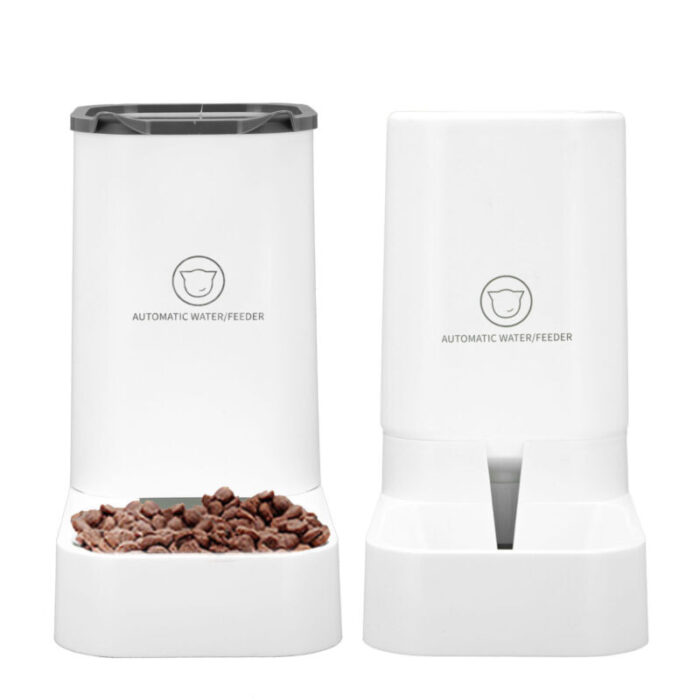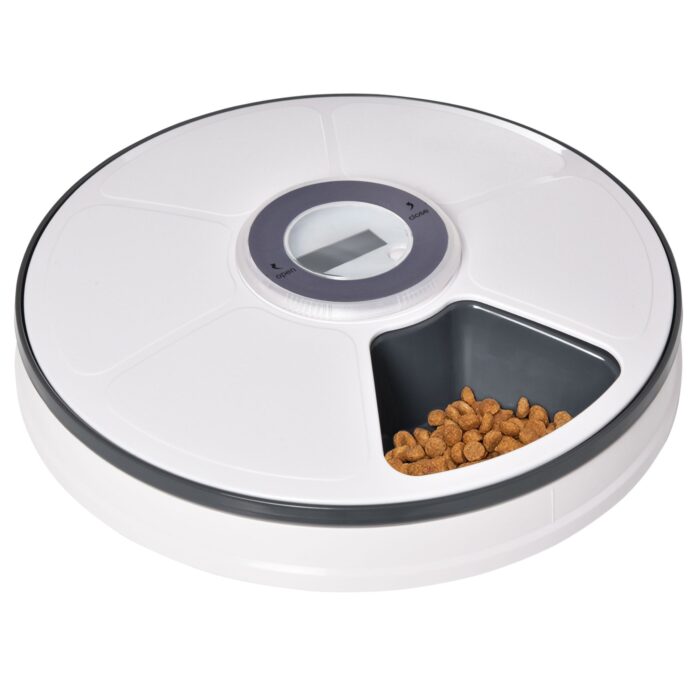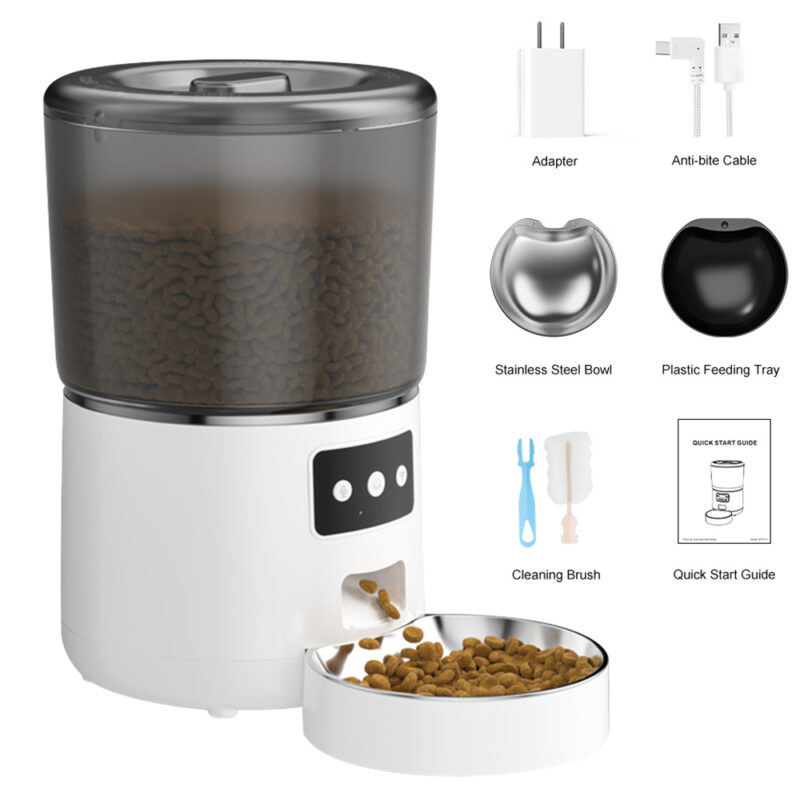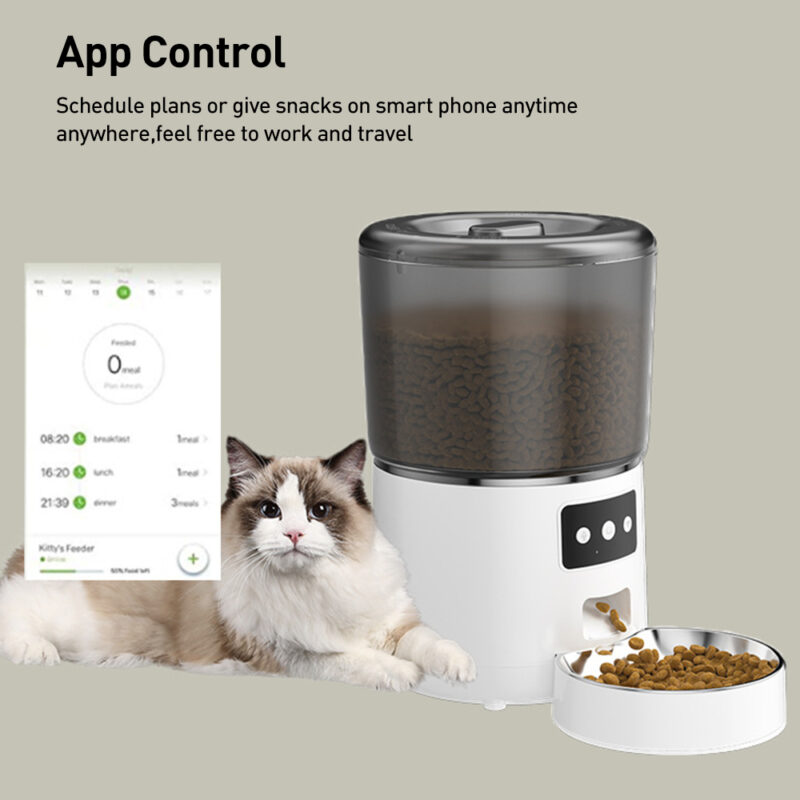Discover the benefits and features of an automatic cat food dispenser, ideal for ensuring your cat is fed on schedule, even when you’re away. Learn about types, usage, and maintenance.
Introduction to Automatic Cat Food Dispensers
In today’s fast-paced world, pet owners often face the challenge of ensuring their pets are well-fed, especially when they are not at home. Automatic cat food dispensers offer a practical solution by automating feeding schedules and controlling portions. These devices not only bring convenience but also ensure that your feline friends maintain a healthy diet, even in your absence.
What is an Automatic Cat Food Dispenser?

An automatic cat food dispenser is a device designed to release a predetermined amount of cat food at set intervals. These dispensers can be programmed to dispense food at specific times, ensuring your cat gets fed regularly without the need for manual feeding.
Types of Automatic Cat Food Dispensers
Programmable Dispensers
Programmable dispensers allow pet owners to set specific feeding times and portions. These are ideal for maintaining a strict feeding schedule and managing portion sizes.
Gravity Dispensers
Gravity dispensers rely on the force of gravity to dispense food. As the cat eats from the bowl, more food is released from the hopper above, making it suitable for cats that self-regulate their eating.
Smart Dispensers
Smart dispensers are connected to Wi-Fi and can be controlled via smartphone apps. These advanced models offer features such as remote feeding, monitoring food levels, and even video capabilities to check on your cat.
How Do Automatic Cat Food Dispensers Work?
Mechanism of Action
Automatic cat food dispensers typically use a timer and a motor to release food. When the set time is reached, the motor activates and dispenses a portion of food into the bowl.
Technology Behind Smart Dispensers
Smart dispensers utilize Wi-Fi connectivity and integrated sensors. They allow owners to monitor and control feeding times remotely, receive notifications, and sometimes even watch their pet through built-in cameras.
Benefits of Using Automatic Cat Food Dispensers
Convenience for Pet Owners
Automatic feeders free up time for pet owners by automating feeding schedules. This is particularly beneficial for those with busy lifestyles or frequent travelers.
Regular Feeding Schedule
Maintaining a consistent feeding schedule is crucial for a cat’s health. Automatic feeders ensure that your cat gets fed at the same times every day, reducing stress and promoting regular eating habits.
Portion Control
Overfeeding can lead to obesity and other health issues in cats. Automatic feeders allow precise portion control, helping maintain your cat’s ideal weight.
Reducing Food Waste
By dispensing only the required amount of food, automatic feeders help reduce food waste and ensure that your cat’s food remains fresh.
Potential Drawbacks of Automatic Cat Food Dispensers
Technical Malfunctions
Like any electronic device, automatic feeders can experience technical issues such as jamming or power failures, which could disrupt your cat’s feeding schedule.
Battery Dependency
Many automatic feeders rely on batteries. If the batteries die, the feeder will not function, potentially leaving your cat without food.
Limited Interaction
Feeding time can be an important bonding moment between pets and their owners. Automatic feeders remove this interaction, which could affect your relationship with your cat.

Are Automatic Cat Feeders a Good Idea?
Factors to Consider
Automatic feeders are a great option for many pet owners, but they are not a one-size-fits-all solution. Consider your cat’s eating habits, health needs, and your lifestyle before investing in one.
When They Are Most Useful
Automatic feeders are particularly useful for maintaining a regular feeding schedule during vacations, long work hours, or in multi-pet households where managing feeding times can be challenging.
Features to Look for in an Automatic Cat Food Dispenser
Capacity
Choose a feeder with a capacity that suits your cat’s dietary needs and your schedule. Larger hoppers mean less frequent refilling.
Programming Options
Look for feeders with flexible programming options to tailor feeding schedules precisely to your cat’s needs.
Power Source
Consider whether the feeder uses batteries, an AC adapter, or both. A backup power source can prevent interruptions.
Material and Durability
Opt for feeders made from durable materials that are easy to clean and resistant to wear and tear.
Popular Brands of Automatic Cat Food Dispensers
PetSafe
Known for their reliable and user-friendly designs, PetSafe offers a range of feeders suitable for various needs.
WOPET
WOPET feeders are popular for their smart features, including app control and camera integration.
Cat Mate
Cat Mate dispensers are valued for their simplicity and efficiency, particularly their models designed for wet food.
Petkit
Petkit offers high-tech solutions with sleek designs, providing smart features and robust build quality.
Comparing Automatic Cat Food Dispensers by Price
Budget-Friendly Options
Affordable feeders often provide basic features and are ideal for those looking for a simple solution without extra frills.
Mid-Range Choices
Mid-range feeders typically offer better build quality and additional features such as programmable timers and portion control.
Premium Dispensers
High-end models come with smart technology, remote control capabilities, and advanced features like cameras and voice recording.
How to Set Up an Automatic Cat Food Dispenser
Initial Setup
Start by assembling the feeder according to the manufacturer’s instructions. Ensure all parts are securely fitted and the feeder is stable.
Programming the Dispenser
Set the feeding times and portions according to your cat’s needs. Refer to the user manual for specific programming steps.
Maintenance Tips
Regularly clean the feeder to prevent food residue buildup. Check and replace batteries as needed to ensure uninterrupted operation.
How Long Can You Leave a Cat with an Automatic Feeder?
Short-Term vs. Long-Term
Automatic feeders are ideal for short-term absences, such as a weekend trip. For longer absences, additional measures like water dispensers and a pet sitter are recommended.
Considerations for Extended Absences
Ensure your cat has enough food, water, and a clean litter box. Arrange for someone to check on your cat periodically to address any issues that might arise.
How to Feed a Cat When on Holiday?
Preparing the Feeder
Before leaving, ensure the feeder is fully operational and stocked with enough food. Test the programming to confirm it dispenses correctly.
Additional Care Tips
Provide multiple water sources, and consider using a water fountain to ensure your cat stays hydrated. Secure your home to prevent your cat from accessing areas where they might get stuck.
Hiring a Pet Sitter
A pet sitter can provide additional care, such as cleaning the litter box, providing fresh water, and offering companionship to your cat.

Can You Put Wet Cat Food in an Automatic Feeder?
Types of Feeders for Wet Food
Certain feeders are specifically designed for wet food and feature compartments that keep the food fresh until it’s time to eat.
Maintaining Freshness
Wet food can spoil quickly, so look for feeders with ice packs or refrigeration capabilities to keep the food fresh.
Cleaning and Maintenance
Wet food feeders require more frequent cleaning to prevent bacterial growth. Follow the manufacturer’s cleaning instructions carefully.
How to Transition Your Cat to an Automatic Feeder
Gradual Introduction
Introduce the feeder gradually, allowing your cat to get used to it. Start by placing it near their usual feeding spot and using it for small meals.
Monitoring Eating Habits
Observe your cat’s eating behavior to ensure they are adjusting well. Make any necessary adjustments to the feeding schedule or portion sizes.
Adjusting Settings as Needed
Based on your observations, fine-tune the feeder’s settings to better match your cat’s eating habits and dietary needs.
Common Issues with Automatic Cat Food Dispensers and Solutions
Jamming
Food jams can occur with certain types of kibble. Opt for a feeder with anti-jamming features and regularly clean the dispenser to prevent blockages.
Power Failures
To avoid power-related disruptions, use feeders with a dual power supply option (batteries and AC adapter) and regularly check battery levels.
Programming Errors
Ensure you follow the programming instructions precisely. If errors occur, reset the feeder and reprogram it as needed.
Maintaining Your Automatic Cat Food Dispenser
Regular Cleaning
Clean the feeder regularly to prevent mold and bacterial growth. Use mild soap and water, and ensure all parts are thoroughly dry before reassembly.
Battery Replacement
Replace batteries as recommended by the manufacturer. Keeping spare batteries on hand can help avoid interruptions.
Checking for Wear and Tear
Periodically inspect the feeder for signs of wear and tear. Replace any damaged parts promptly to maintain optimal functionality.
Automatic Cat Food Dispensers for Multi-Cat Households

Managing Feeding Times
In multi-cat households, managing feeding times can be challenging. Automatic feeders can help by providing consistent and separate feeding schedules for each cat.
Preventing Food Hoarding
Some cats might hoard food, preventing others from eating. Consider using multiple feeders or a feeder with a unique access system to ensure fair distribution.
Ensuring Equal Access
Place feeders in different locations to reduce competition and stress among cats, ensuring that each cat has equal access to food.
The Environmental Impact of Automatic Cat Food Dispensers
Energy Consumption
Smart feeders and those with additional features may consume more energy. Opt for energy-efficient models to minimize environmental impact.









